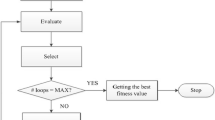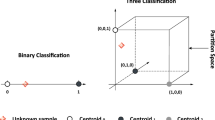Abstract
Aiming at the difficulty of obtaining a large number of labeled samples of the shortwave receiving system, an intelligent diagnosis method for the shortwave receiving system based on the improved Laplacian SVM algorithm is proposed. By introducing the idea of neighborhood density into the adjacency graph construction of Laplacian SVM, the manifold structure information of samples is more fully mined, thus improving the performance of Laplacian SVM classifier and realizing the optimization of traditional Laplacian SVM. KFCM clustering algorithm was used to select unlabeled boundary samples and labeled samples to form the reduction training set. The method of the KFCM pre-selection sample was combined with the improved Laplacian SVM algorithm to enhance the learning efficiency. The simulation results using the UCI data set and the experimental verification results of shortwave receiving system sample data indicate that the proposed algorithm could more fully mine the manifold structure information of samples and improve the performance of the Laplacian SVM classifier.



Similar content being viewed by others
Reference
Ding S, Zhu Z, Zhang X (2017) An overview on semi-supervised support vector machine %. J Neural Computing and Applications. 28(5):89
Liu Y, Xu Z, Li CJIS (2018) Online semi-supervised support vector machine.
Chidambaram S, Srinivasagan KGJCC (2018) Performance evaluation of support vector machine classification approaches in data mining.
Bzdok D, Krzywinski M, Altman NJNM (2018) Machine learning: Supervised methods. SVM and kNN. 15(1):72
Liu Z, Liu H, Zhao ZJWPC (2018) Weighted Least Squares Support Vector Machine for Semi-supervised Classification. J Appl poly sci. 103(3):1–12
Cui J, Shang W, Wan M, Zhao J, Yuan W, Zeng PJI, Control (2017) Intrusion Detection of Industrial Control Based on Semi-supervised Clustering Strategy.
Belkin M, Niyogi PJNC (2014) Laplacian Eigenmaps for Dimensionality Reduction and Data Representation 15(6):1373–1396
Gu Y, Feng KJIJoSTiAEO, Sensing R (2013) Optimized Laplacian SVM With Distance Metric Learning for Hyperspectral Image Classification. 6 (3); 1109–1117
Xuanyu Z, Juan L, electronics SJJo (2016) Chinese anaphora resolution method based on measure optimization Laplacian SVM. (12)
Shaona, Wang, Shuyuan, Letters YJRS (2016) Saliency-guided change detection for SAR imagery using a semi-supervised Laplacian SVM: Remote Sensing Letters: Vol 7, No 11.
Zhen L, Junan Y, system LHJM (2016) Laplacian Support Vector Machine by Local Behavioral Similarity. 037 (012):2749–2754
Girolami MJIToNN (2002) Mercer kernel-based clustering in feature space. 13 (3):780–784
Qi Z, Tian Y, Shi YJIToNN, Systems L (2015) Successive Overrelaxation for Laplacian Support Vector Machine 26(4):674–683
Wang Sha-fei, Yang Jun-an, Processing W-jJJoS (2014) Semi-supervised learning algorithm and application based on local behavioral searching strategy. (12):1443–1449
Wang YL, Chen B, Wang XL, Gui WHJC, Decision (2014) Improved adaptive spectral clustering algorithm based on density adjustment. 29(9):1683–1687
Li Y, Liu X, Yan X (2016) A modified spectral clustering algorithm based on density. Springer International Publishing
Yang A, Jiang L, Zhou Y A (2007) KFCM-based fuzzy classifier. In: International conference on fuzzy systems & knowledge discovery
Liu ZZ, Li SN, Zhang X, Guo WQJAES (2018) Link quality prediction algorithm based on improved kernel FCM and intelligent SVR for WSNs. 46(1):90–97
Author information
Authors and Affiliations
Corresponding author
Additional information
Publisher's Note
Springer Nature remains neutral with regard to jurisdictional claims in published maps and institutional affiliations.
Rights and permissions
About this article
Cite this article
Luo, Y., Xiang, Y. & Zhong, S. A study on intelligent diagnosis model of shortwave receiving system based on improved KFCM and LapSVM. Pattern Anal Applic 24, 1377–1386 (2021). https://doi.org/10.1007/s10044-021-00957-1
Received:
Accepted:
Published:
Issue Date:
DOI: https://doi.org/10.1007/s10044-021-00957-1




